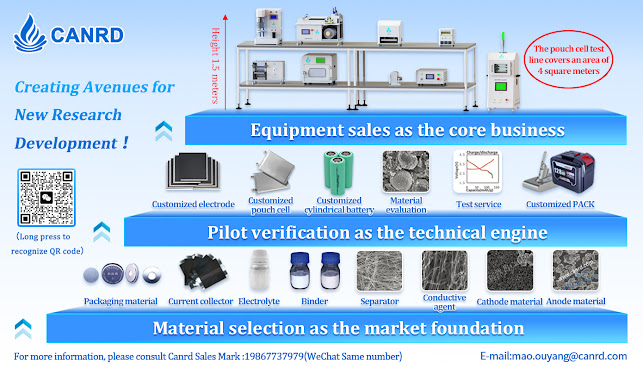In the structure of lithium batteries, battery separator refers to a layer of separator material between the positive and negative electrodes of the battery. It is a very critical part of the battery and has a direct impact on the safety and cost of the battery. Its main function is to isolate the positive and negative electrodes and prevent the electrons in the battery from passing freely, so that the ions in the electrolyte can pass freely between the positive and negative electrodes. The performance of the separator determines the interface structure and internal resistance of the battery, which directly affects the battery's capacity, cycle and safety performance. According to the differences in physical and chemical properties, lithium-ion battery separators can be divided into several categories: woven membranes, non-woven membranes (non-woven fabrics), microporous membranes, composite membranes, separator paper, rolled membranes, etc. Although there are many types, the main commercial lithium-ion battery separator materials are polyethylene and polypropylene microporous membranes. Polyolefin materials have excellent mechanical properties, chemical stability and relatively low prices. Therefore, polyolefin microporous membranes such as polyethylene and polypropylene have been used as lithium-ion battery separators in the early stages of lithium-ion battery research and development.
1. Impact on Security
A thicker diaphragm can better ensure the isolation of the positive and negative electrodes inside the lithium-ion battery when it is impacted by external objects, so a thicker diaphragm also means better safety.
Since lithium-ion batteries heat up during continued use, the separator generally has the added function of providing a thermal shutdown. When the internal resistance of the lithium-ion battery pack increases by three orders of magnitude, the thermal shutdown function of the separator will begin to be used.
2. Impact on voltage
The thinner the diaphragm is, the shorter the channel for ion migration is, the weaker the polarization phenomenon is, and the lower temperature voltage platform of lithium-ion batteries is relatively higher. Excessive pores in the diaphragm will accelerate the self-discharge process of lithium-ion batteries, thereby reducing the voltage consistency of the battery.
3. Impact on internal resistance
The air permeability of the diaphragm is proportional to the internal resistance of the lithium-ion battery equipped with it, that is, the higher the air permeability of the diaphragm, the greater the internal resistance of the lithium-ion battery.
Whether the diaphragm can be completely wetted by the electrolyte used in lithium-ion batteries will also affect the internal resistance of the battery. The degree of electrolyte wettability is related to the diaphragm material itself and its internal microstructure.
Lithium battery separator is one of the four key materials that affect the performance of lithium batteries in many aspects. It directly determines and comprehensively affects the key performance indicators of lithium batteries such as energy density, cycle performance, rate performance, internal resistance, and safety performance such as high temperature resistance, flame retardancy, self-shutdown, and electrochemical stability. If the permeability of the separator is high, the surface density of the membrane will be reduced, which will have a certain impact on the performance of the battery.
The main quality control indicators of battery separators include: air permeability test,thickness test, physical mechanical properties (tensile strength, elongation at break,puncture strength, etc.), thermal shrinkage performance test, in addition to water
vapor permeability test for battery packaging and overall sealing of battery products.
In batteries of the same size, the thicker the separator, the fewer layers that can be wound, and the corresponding capacity will be lower; but on the other hand, thicker products will have slightly higher puncture resistance and higher safety.At the same time, under the same porosity, the thicker the product, the worse the
air permeability, which makes the internal resistance of the battery higher.
What is the thickness of lithium battery separator?
For consumable lithium batteries (cell phones, laptops, digital cameras), 25 microndiaphragms have gradually become the standard. However, due to the growing use of portable products, thinner diaphragms, such as 20 microns, 18 microns, 16 microns, and even thinner diaphragms have begun to be widely used. Generally speaking, the thickness of the diaphragm directly affects the safety, capacity, and internal resistance of lithium batteries. For power batteries, due to the mechanicalrequirements of the assembly process, thicker diaphragms are often required. Ofcourse, for large batteries used for power, safety is also very important, and thickerdiaphragms often mean better safety. The thickness of the commonly used diaphragms is generally 9~32um.
Whether the thickness of lithium battery separator is uniform is the basis for testing its various properties. It is measured by mechanical contact method . Generally,it must be controlled within 1um. Uneven thickness will affect the performance such as air permeability and tensile strength. Controlling thickness is also an important means to ensure quality and control costs.
Canrd Brief Introduce
Canrd use high battery R&D technology(core members are from CATL) and strong Chinese supply chain to help many foreign companies with fast R&D. We provide lab materials, electrodes, custom dry cells, material evaluation, perfomance and test, coin/pouch/cylindrical cell equipment line, and other R&D services.
Email: contact@canrd.com Phone/Wechat/WhatsApp: +86 19867737979
Canrd Official Web Canrd Company Vedio Canrd Company profile
Website : www.canrud.com











The rechargeable lithium battery price in Pakistan starts around Rs. 7,000. These batteries are ideal for repeated charging cycles and long-term use in UPS, solar, and electric systems.
ReplyDelete